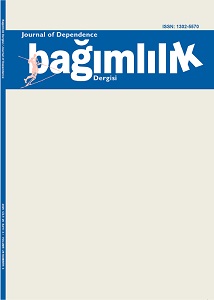ABUSE OF SİNEMET® (LEVODOPA/CARBİDOPA COMBİNATİON) İN A PATİENT WİTH SCHİZOPHRENİA
Keywords:
Sinemet®, schizophrenia, drug abuse, antiparkinsonian drugs, levodopa/carbidopaAbstract
Sinemet® is a combination of carbi-dopa and levodopa (L-dopa) that is used to treat Parkinson’s disease and syndrome. L-dopa is considered the gold standard of drug therapies for the treatment of Parkinson’s disease because it is the metabolic precursor of dopamine, crosses the blood-brain barrier, and is presumably converted to dopamine in the brain. Drug abuse is the patterned use of a substance (drug) in which the user consumes the substance in amounts or through methods not supported by the advice of medical professionals. Patients with Parkinson’s disease require escalations in the dose of the dopamine agonists that are used to treat this disease as it progresses, and it is possible that this may lead to psychological dependence and abuse as the dose increases. The abuse potential of anticholinergic drugs is well known, but there is limited research regarding the abuse potential of dopamine agonists in the medical literature. Thus, in this case report, it was aimed to discuss abuse of Sinemet® in a patient with schizophrenia.
References
Münchau A, Bhatia KP. Pharmacological treatment of Parkinson’s disease. Postgrad Med J 2000; 76: 602–610.
Lavin MR. Neuroleptic-induced extrapyramidal side effects. Am J Psychiatry 1993; 150: 1752-3.
Karataş Y. Treatment of Parkinson’s disease. Türkiye Klinikleri J Int Med Sci 2005; 1: 67-75.
Caplan JP, Epstein LA, Quinn DK, et al. Neuropsychiatric effects of prescription drug abuse. Neuropsychol Rev 2007; 17: 363–380.
Rabinak CA, Nirenberg MJ. Dopamine agonist withdrawal syndrome in Parkinson disease. Arch Neurol 2010; 67: 58-63.
Dose M, Tempel HD. Abuse potential of anticholinergics. Pharmacopsychiatry 2000; 33 (Suppl 1):43-46
Nusieda PA. Sinemet abusers. Clin Neuropharmacol 1985; 8: 318-27.
Nissenbaum H, Quinn NP, Brown RG, et al. Mood swings associated with the ‘on–off’ phenomenon in Parkinson’s disease. Psychol Med 1987; 17: 899–904.
Witjas T, Kaphan E, Azulay JP, et al. Nonmotor fluctuations in Parkinson’s disease: Frequent and disabling. Neurology 2002; 59: 408–13.
Dagher A, Robbins TW. Personality, addiction, dopamine: Insights from Parkinson’s disease. Neuron 2009; 61: 502-10.
Evans AH, Lawrence AD, Cresswell SA, et al. Compulsive use of dopaminergic drug therapy in Parkinson’s disease: Reward and anti-reward. Mov Disord 2010; 25: 867–76.
Merims D, Giladi N. Dopamine dysregula-tion syndrome, addiction and behavioral changes in Parkinson’s disease. Parkinsonism Relat Disord. 2008; 14: 273-80.
Quinn NP, Toone B, Lang AE, et al. Dopa dose-dependent sexual deviation. Br J Psychiatry 1983; 142: 296–8.
Vogel HP, Schiffter R. Hypersexuality -a complication of dopaminergic therapy in Parkinson’s disease. Pharmacopsychiatria 1983; 16: 107–10.
Priebe S. Levodopa dependence: A case report. Pharmacopsychiatria 1984; 17: 109–10.
Tack E, De Cuypere G, Jannes C, Remou-champs A. Levodopa addiction: A case study. Acta Psychiatr Scand 1988; 78: 356–60.
Uitti RJ, Tanner CM, Rajput AH, et al. Hypersexuality with antiparkinsonian therapy. Clin Neuropharmacol 1989; 12: 375–83.
Soyka M, Huppert D. L-dopa abuse in a patient with former alcoholism. Br J Addict 1992; 87: 117–18.
Weinman E, Ruskin PE. Levodopa dependence and hypersexuality in an older Parkinson’s disease patient. Am J Geriat Psychiat 1995; 3: 81–83.
Spigset O, von Scheele C. Levodopa dependence and abuse in Parkinson’s disease. Pharmacotherapy 1997; 17: 1027–30.
Merims D, Galili-Mosberg R, Melamed E. Is there addiction to levodopa in patients with Parkinson’s disease? Mov Disord 2000; 15: 1014–16.
Houeto JL, Mesnage V, Mallet L, et al. Behavioral disorders, Parkinson’s disease and subthalamic stimulation. J Neurol Neurosurg Psychiatry 2002; 72: 701–07.
Giovannoni G, O’Sullivan JD, Turner K, et al. Hedonistic homeostatic dysregulation in patients with Parkinson’s disease on dopamine replacement therapies. J Neurol Neurosurg Psychiatry 2000; 68: 423–28.
Spanagel R, Heilig M. Addiction and its brain science. Addiction 2005; 100: 1813–22.
Juckel G, Schlagenhauf F, Koslowski M, et al. Dysfunction of ventral striatal reward prediction in schizophrenic patients treated with typical, not atypical, neuroleptics. Psychopharmacology (Berl). 2006; 187: 222-8.
Downloads
Published
How to Cite
Issue
Section
License
Copyright (c) 2025 Journal of Dependence

This work is licensed under a Creative Commons Attribution-NonCommercial-NoDerivatives 4.0 International License.
...
